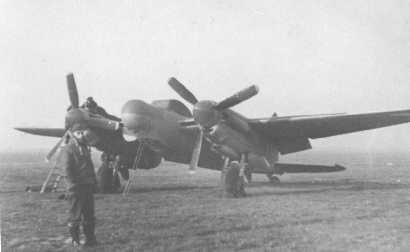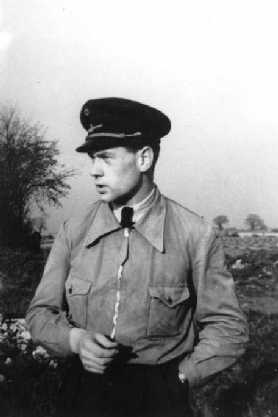

In August 1940, a part of the Belgian Air Force arrived in the UK. The young Belgian future aviators were trained on modern machines and were sent to front units quickly. Albert Custers was the first of the Belgians to fly in the Coastal Command Squadrons.
During a war mission, his plane crashed in the sea. Luckily the crew was rescued. The Belgians then feared to fly over the sea.
Albert Custers became an instructor (in 1943), and at that time many French and Belgian volunteers had arrived in England and had to be trained again. Albert Custers could speak English and French, so he could teach many pupils.
Albert Custers trained to fly a Mosquito (a British bomber, though there was a reconnassaince, fighter-bomber, and fighter/nightfighter version. He flew the nightfighter one.) His crewmate was Irish.
The Belgian-Irish crew began their first flights at Hunston airbase. There were many boring missions with no interceptions. On Sept. 6, 1944, the Belgian crew of Walter Henri/Henri Huyen came. Huyen, as his pilot, was born around Liege. He flew before the war, and his squadron was equipped with Fairey Battles. He was a gunner. At age 39, he decided to escape from occupied Belgium, and after many adventures, got to England in 1943.
In October, 219 moved to the mainland, to the French airfiield of Amiens-Glisy. A fourth Belgian flier comes in. His name was Ferdinand Vandenheuvel. He was in the Belgian land army in May 40, and got to England from Dunkirk. He entered in the Belgian Armored Troops, but in 1942 he volunteered for the RAF. As a Navigator, he was with F/Lt Reynolds.
On 19 November, some more Belgians land at Glisy. His name was Albert Petrisse and was a policeman until 1941 when he escaped from Belgium via Spain. In Chimay he met a student that he had been trained with in Canada. His name was Faurice Laloux. They then decided to fly together.
The Belgian fliers will learn the common life of a nightfighter in 1945. German raiders are scarce and patrols are disappointing. About every time the saw another aircraft it turned out to be another nightfighter, or a bomber coming back from a late night mission. Surprisingly on 2 January, 1945 the crew Vandenheuvel/Reynolds shot down a Messerschmit Bf 110.
In about February, another Belgian crew comes in. One was Alexis Besschops. He left occupied Belgium with his family and went to the Belgian Congo. In 1941 he volunteered for the RAF and left the Congo. He was a friend of Albert Petrisse and were trained together in Canada. So he asked to be in the same squadron with Petrisse.
The other was Richard Delbrouck who was born in Liege. He was an engineer and lived in Antwerp. He married a young local girl.
Tragic Losses
But then came tragic losses from 219. When Reynolds suffers from engine stoppage while taking off, he crashes. Reynolds and Vandenheuven both were killed.
About two weeks later, Squadron 219 was moved to an airfield in the Netherlands. Then the crew Henri/Huyen failed to make it back from a mission. They were hit badly by flak near Cologne and crashed in the Netherlands. They were buried by there crashed plane.
Then on 18 April, Petrisse and Laloux don't make it back. Again the cause was flak. They crashed at Visselhovede. Their bodies were buried at Wehenson cemetery (near Soltau).
The Final Weeks
Custers was now the sole survivor of the Belgian crews. On 12 March he finished his tour but decided to remain with his squadron. Squadron 219 was reinforced with 3 more Belgians. First came Jean Pirson in the end of March. And then came Robert "Bob" Nyssens and Henri "Coco" Lenoard came in the beginning of April. These pilots weren't heavily engaged because the war was almost over.
The last casualties were on 3 September, when Besschops and Delbrouck's twin engine crashed and exploded on a mountain.
11 Belgians were in Squadron 219. 5 were killed before VE Day (Victory in Europe Day). The Belgians lost around 65% losses. The only non Belgian in the unit was the Frenchmen Commandant Claisse. He was a test pilot before the war and survived the conflict.
In September 1946, the Squadron 219 was disbanded for the last time.
